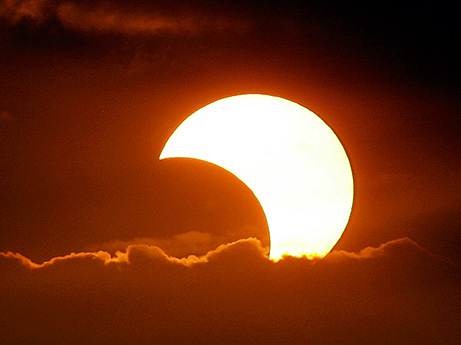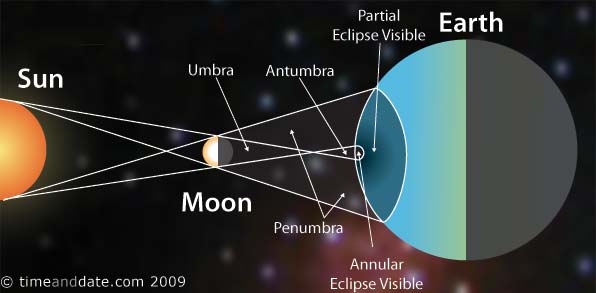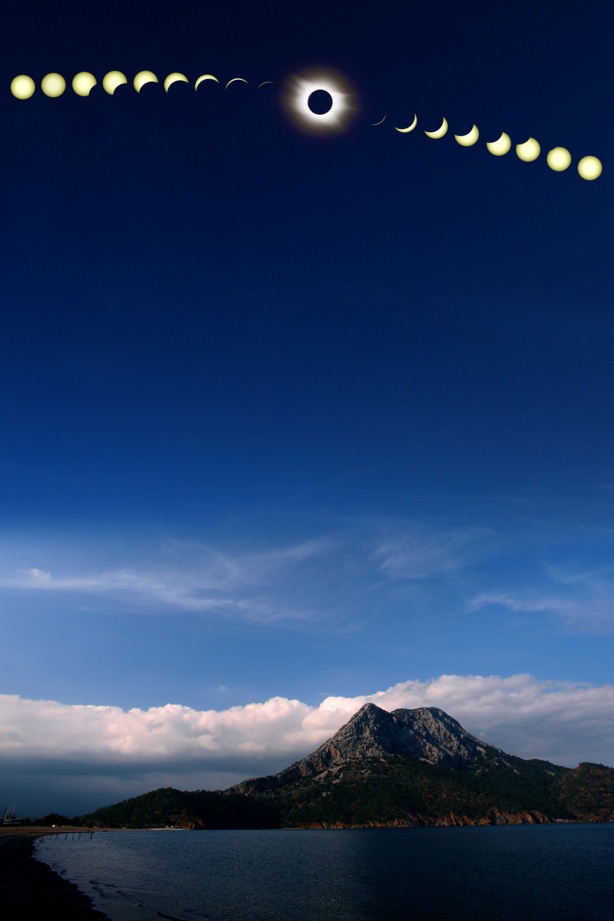The Eclipse Prayer:
Salaat-ul-kusoof (Solar Eclipse prayer) and Salaat-ul-Khusoof (Lunar Eclipse prayer
 A solar eclipse
A solar eclipseThe prayers for a lunar eclipse and a solar eclipse is the same. It’s important to pray this in congregation, although praying alone is permissible too. The importance is because the Prophet (peace be upon him) instructed us to remember Allah and invoke Allah during this time, and this was also a time when the Prophet (peace be upon him) was afraid of what was to come.
Narrated `Abdullah bin `Amr : “When the sun eclipsed in the lifetime of Allah’s Apostle an announcement was made that a prayer was to be offered in congregation.” [Bukhari, 2.155]
The eclipses do not happen because someone has died and this is clear from the following hadith:
Narrated Abu Bakr: We were with Allah’s Apostle when the sun eclipsed. Allah’s Apostle stood up dragging his cloak til he entered the Mosque. He led us in a two-rak`at prayer till the sun (eclipse) had cleared. Then the Prophet (p.b.u.h) said, “The sun and the moon do not eclipse because of someone’s death. So whenever you see these eclipses pray and invoke (Allah) till the eclipse is over.” [Bukhari, 2.150]
Narrated Al-Mughira bin Shu`ba: “The sun eclipsed in the lifetime of Allah’s Apostle on the day when (his son) Ibrahim died. So the people said that the sun had eclipsed because of the death of Ibrahim. Allah’s Apostle said, “The sun and the moon do not eclipse because of the death or life (i.e. birth) of someone. When you see the eclipse pray and invoke Allah.” [Bukhari, 2.153]
 Diagram showing how a solar eclipse occurs
Diagram showing how a solar eclipse occursSO HOW DO YOU PRAYER THE ECLIPSE PRAYER?
An Eclipse prayer is made up of two rakaats of prayer (two units of prayer). Basically there are two rukus (bowings) and two recitations from Qur’an in each unit of prayer (rakaat) – in normal prayer, there is only one bowing per unit of prayer (see my post on How to Pray).
- So you stand up for prayer as normal
- Recite Qur’an as you normally would
- Go into Rukoo (bow) and prolong the rukoo with duas
- Stand up and recite Qur’an again
- Go into Rukoo (bow) again and prolong the rukoo with duas but not as long as the first rukoo
- Stand up and then go into sujood (prostration) and prolong the sujood with duas
- Sit up straight
- Go into sujood again and prolong it (but not as long as the first sujood)
- You repeat the above steps for the second rakaat (second unit of prayer)
The prayer is described in the following hadiths:
Narrated `Aisha: In the lifetime of Allah’s Apostle (p.b.u.h) the sun eclipsed, so he led the people in prayer, and stood up and performed a long Qiyam, then bowed for a long while. He stood up again and performed a long Qiyam but this time the period of standing was shorter than the first.
He bowed again for a long time but shorter than the first one, then he prostrated and prolonged the prostration. He did the same in the second rak`a as he did in the first and then finished the prayer; by then the sun (eclipse) had cleared. He delivered the Khutba (sermon) and after praising and glorifying Allah he said, “The sun and the moon are two signs against the signs of Allah; they do not eclipse on the death or life of anyone. So when you see the eclipse, remember Allah and say Takbir, pray and give Sadaqa.” The Prophet then said, “O followers of Muhammad! By Allah! There is none who has more ghaira (self- respect) than Allah as He has forbidden that His slaves, male or female commit adultery (illegal sexual intercourse). O followers of Muhammad! By Allah! If you knew that which I know you would laugh little and weep much. [Bukhari, 2.154]

Narrated `Aisha: (the wife of the Prophet (p.b.u.h) In the lifetime of the Prophet the sun eclipsed and he went to the Mosque and the people aligned behind him. He said the Takbir (starting the prayer) and prolonged the recitation (from the Qur’an) and then said Takbir and performed a prolonged bowing; then he (lifted his head and) said, “Sami allahu liman hamidah” (Allah heard him who sent his praises to Him). He then did not prostrate but stood up and recited a prolonged recitation which was shorter than the first recitation. He again said Takbir and then bowed a prolonged bowing but shorter than the first one and then said, “Sami`a l-lahu Lyman hamidah Rabbana walak-lhamd, (Allah heard him who sent his praises to Him. O our Sustainer! All the praises are for You)” and then prostrated and did the same in the second rak`a; thus he completed four bowing and four prostrations. The sun (eclipse) had cleared before he finished the prayer. (After the prayer) he stood up, glorified and praised Allah as He deserved and then said, “The sun and the moon are two of the signs of Allah. They do not eclipse because of the death or the life (i.e. birth) of someone. When you see them make haste for the prayer.” Narrated Az-Zuhri: I said to ‘Urwa, “When the sun eclipsed at Medina your brother (`Abdullah bin Az-Zubair) offered only a two-rak`at prayer like that of the morning (Fajr) prayer.” ‘Ursa replied, “Yes, for he missed
the Prophet’s tradition (concerning this matter).” [Bukhari, 2.156]
Narrated `Abdullah bin `Amr When the sun eclipsed in the lifetime of Allah’s Apostle and an announcement was made that the prayer was to be held in congregation. The Prophet performed two bowing in one rak`a. Then he stood up and performed two bowing in one rak`a. Then he sat down and finished the prayer; and by then the (eclipse) had cleared `Aisha said, “I had never performed such a long prostration.” [Bukhari, 2.160]
I also found the following short instruction on the Eclipse Prayer useful (by Salafi Publications)
I hope I haven’t confused anyone but please ask if I have. Insha’Allah if I can answer in time before the prayer begins, I will
https://standup4islam.wordpress.com/2011/01/04/the-eclipse-prayer-salaat-ul-kusoof-solar-eclipse-prayer-and-salaat-ul-khusoof-lunar-eclipse-prayer/
Stand Up 4 Islam!











